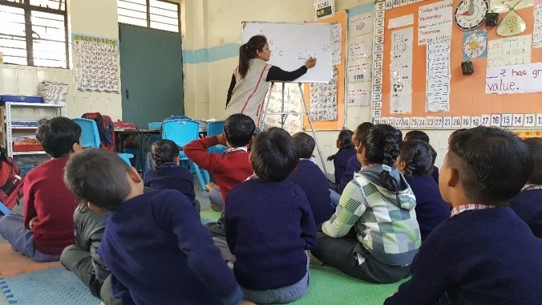This post by Natalie Lamprell, Rising’s Director of Curriculum and Teacher Development, originally appeared on the Global Schools Forum blog.
Principal Chitra Vishwanathan welcomes us into her office at Abhuyudaya Nagar MPS, a government school in Mumbai supported by the Akanksha Foundation. We sip on chai as Chitra leans forward in her chair, smiles and tells us about her school. She has 35 teachers; some are veterans, some are ‘Teach for India’ newbies and some, regardless of experience, need more of her instructional support. She has 565 students and invests time in building strong relationships with their parents. Her walls are adorned with personalised ‘Super Mum and Dad’ displays.
Super Dad Display in the office of the Abhuyudaya Nagar school, Mumbai
But there’s only so much chai and chat Chitra can spare. As Uncommon Schools Chief Schools Officer Paul Bambrick-Santoyo states in his book Leverage Leadership, school leaders should be “relentless about spending time on the most important things”. Before long, Chitra says her goodbyes and heads off into the school and back to her core mission. She begins the day with a learning walk before monitoring today’s attendance data.
Seeing Chitra and her school in action filled me with hope – an excellent school leader is the key to unlocking excellent teaching and learning. But it also made me think about how you address this critical need for focused, skilled school leaders in more remote locations and at scale.
Chitra was just one of the inspiring school leaders I met during a week-long study tour to Mumbai and Delhi arranged by the Global Schools Forum. There are 260 million schoolchildren in India attending over 1.5 million schools. The task of guaranteeing them a great education is gargantuan. The Study Tour was designed to expose participants to some innovative non-state operators in this context. Many of the attendees work in Sub -Saharan Africa where the scale of the task is also daunting and is set to get even greater; by 2050 three quarters of a billion children will attend school. Throughout the week we found ourselves grappling with the same key question: how can we recruit, equip and retain excellent school leaders?
Phonics lesson in progress in a Peepul classroom, Delhi
At the Peepul-SDMC partnership school in Dayanand Colony in Delhi, Education Director Urmila Chowdhury takes a grow-your-own approach to her future school leaders. She recently promoted two teachers working in the school to Academic Coordinators. They may be younger and less formally qualified than potential external hires, but their time with the organisation means that they have the DNA of Peepul – a relentless focus on best classroom practice. They are deeply committed to the community they were already serving as teachers and they are here to stay.
Matthew Bidwell, a Professor of Management at the Wharton School, has studied the merits of hiring externally versus promoting from within. Much of it comes down to a question of relationships. In a 2011 paper he notes, “we have relationships in organizations that are key to getting work done and a set of structures and routines we need to know” . Bidwell’s analysis feels especially true of schools, whereschool leaders must build a multitude of relationships with students, parents, teachers, middle leaders, the wider community and education ministries. Mainak Roy CEO of Simple Education Foundation (S.E.F) agrees that relationships are paramount. The management team of S.E.F spend lots of their time in the government schools they support to build these relationships before rolling out new initiatives.
In his paper Bidwell goes on to say that an external hire often slows down the performance of the whole team while they try to get the new person up to speed. By contrast, an internal hire can hit the ground running and serve as an example to the rest of the team about what behaviours get rewarded. Seeing their peers progress into management roles can motivate other teachers to strive to achieve the same progress, ensuring there is a talent pipeline within the organisation who, if needed, can be deployed to locations further afield.
At the Pratham learning centre in Delhi
But the step from teacher to school leader is a big one. How do we equip our leaders with the tools to approach their role with what Bambrick-Santoyo calls “an engineer’s obsession”? A clue came during one of our first visits, to Lead School Mangaon Campus, three hours from Mumbai. Their bespoke school management system allows all the school leaders in their network to log on and crunch item level student assessment data and then coordinate effective remediation programmes (like the rigorously evaluated TaRL – Teaching at the Right Level - sessions Pratham have pioneered). Accurate, regular, timely data is driving the academic performance of their students and HQ can look at these results in real time remotely.
Across the week we discussed how different school networks were finding their own route to recruiting, developing and supporting school leaders. But running through all these approaches was a common thread: put your mission at the heart of what you do.
I am keen to continue the discussions we began in India about school leadership. In the new year GSF’s Keya Lamba and I intend to set up a Chief Academic Officer community of practice and I’d like to work with this group to chart the roadmap for our instructional leaders from novice to excellent.
Thank you to GSF for hosting the trip, to the schools we visited for being so welcoming and inspiring, and to my fellow delegates for all the learning (and the laughs along the way).



